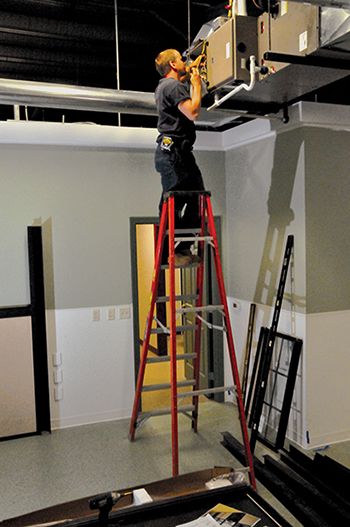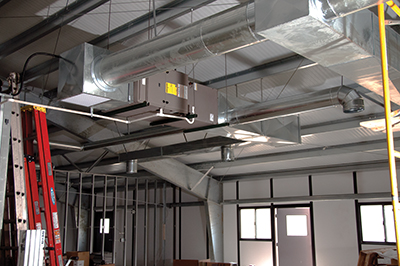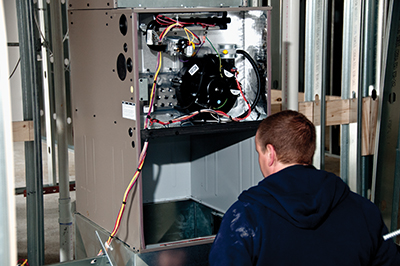
Kennel Heating Systems
By Craig McAllester
It’s getting colder outside. Last night we put another blanket on the bed. Soon, snow will be falling. Perhaps it’s just an ‘occupational hazard,’ but, as each season begins to change, I think about my mechanical system. I fully understand its importance in our lives. However, it is comforting for me to know that if our furnace should fail, most any competent mechanical contractor would be able to size and install a new heating system. Because we have two separate heating sources in our home (electric and wood fired), we would likely be okay for a week or so, aside from a little inconvenience, and the cost of a new furnace.

Photographs by Kennel Design USA
When it’s time to buy new heating equipment for your kennel, designing such a system is not so straightforward. The air quality of a kennel is very different than that of a home or office building. An animal shelter is most often full, if not overflowing. That, along with all the open water bowls and all the cleaning that is taking place within the kennel, water is constantly being evaporated into the air. This moisture will remain in the building until it is exhausted to the outdoors. If this wet air goes unchecked, the warm and wet environment becomes a perfect medium for the growth of mold, mildew and bacteria making for an unhealthy building, or, what I call, a sick building. It’s the mechanical equipment that will eliminate this water from the building, providing the kennel with a healthy indoor air quality.
In addition to the kennel itself, there are some other areas in the building that have additional requirements for maintaining air quality. Surgical suites or treatment rooms should be provided with PPV, (Positive Pressure Ventilation). This will maintain clean, filtered air in those areas. Doing so, will help to minimize postoperative infections. As a door to the positive pressure room is opened, this slightly higher (positive) air pressure inside the room rushes out of the doorway, pushing away any airborne contaminants, thereby preventing their entry.

Quarantine rooms work just the opposite way. They are designed with a NPV, (Negative Pressure Ventilation), to prevent the spread of disease throughout the facility. Air in these spaces is constantly being drawn into the quarantine room. Doing so prevents airborne contaminants in the quarantine room from getting out the door and into other areas of the building. The air in a quarantine ward will never be reused in the building, but is exhausted to the outside. The cattery is similar to the quarantine room, in that, the air is exhausted to the outside.
All these concerns are addressed by a properly designed forced air, mechanical system. Now you can begin to see that this is not a simple heating system. When you need a new furnace, be sure to consider all the demands that will be placed on it over the course of a year.
Here are some considerations, and your facility may have additional requirements:
- Heating the building in the winter.
- Cooling the building in the summer.
- The mechanical system must include a ventilation system to circulate air within the building, and will filter the air removing dust and allergens.
- The ventilation system will exhaust stale air outside and will bring in fresh air.
- Quarantine areas will have NPV to exhaust contaminants outside.
- Surgical areas will have PPV to prevent contaminants from entering clean areas.
- It will remove moisture that has evaporated into the air.
From this list, we can begin to see how the sum of these parts makes up the whole, and how everything must work together. A properly designed forced air HVAC (Heating, Ventilation, and Air Conditioning) system will handle all of these tasks. The heating fuel source may be gas, electric, or other.

For new construction, with a highly insulated and airtight building, ask your mechanical engineer about adding an ERV (Energy Recovery Ventilator) to the ventilation system. An ERV will recover the energy (the warm air in the winter and the cool air in the summer) in the air before it is exhausted. Then it will use that energy to pre-warm (winter) or pre-cool (summer) the air coming into the building. This pre-conditioning saves money on heating and cooling costs.
There are a lot of different types of heating systems, and each has its own advantages. It is important to understand that the best heating system for a home is not necessarily the best for use within a kennel.
A good example of this is radiant floor heating. If I were building a new home today, for my family, radiant floor heating would be my first choice for a heating solution. I’m sure that is why, several times a year, a new client asks me to use radiant floor heating in the design of their new kennel—it is known as the highest quality home heating product available today. We all want the best for our families and for our animals too. Aside from the lack of ventilation in the winter months, radiant heat flooring turns the entire floor of the building into a radiator, so it becomes the warmest part of the building. Perfect for us people-types, but who wants their dog lying on a radiator? Consider too, that some systems are better than others for animals.
If you were to use a separate heating system, all winter long, you would likely not be able to filter the air, or exhaust the stale air and moisture to the outside. During the winter the heat would be turned on, but the other parts (ventilation and air conditioning) would likely be turned off waiting for warmer weather.
By no means am I saying that all types of radiant heat are bad. I have often used small, localized area radiant heat sources in conjunction with HVAC heating systems. Doing so will allow the owner to keep the ambient temperature of the entire kennel ward low, and then provide a little extra, supplemental heat in the kennel stalls as the need arises. For example, if my Shih Tzu, Gordon, was being boarded in the same ward as an Alaskan Husky sled dog team on a cold night, Gordon may need a little extra heat! Spot heating like this also helps to save on heating costs if your occupancy is not at full capacity.
Most any heating source will work just fine, if measures are made to clear the air of evaporated water. The number of air changes per hour will depend on the use and your local codes. So, if you get that musty, wet, and sometimes overpowering, knock-you-over smell the second you walk through the doors of your kennel, you should consult with a mechanical engineer, pronto. That smell, or lack there of, is the first impression your would-be customer will have as they walk through your doors; make it a good one! Consulting with an engineer who is familiar with the workings of a kennel or animal shelter will go a long way in keeping your facility healthy for both the staff and its four pawed tenants.
Contributions from Jamie Tiglas, P.E., LEED, AP, Mechanical Engineer.
Craig L. McAllester, President, Craig L. McAllester, Inc, Kennel Design USA, has been designing veterinary hospitals, boarding kennels, animal shelters and police, military, and U.S. Department of HomeLand Security/Border Patrol working dog kennels here in the United States of America, and in countries around the world, since 2003. Craig may be contacted at 877-234-2301. [email protected] www.KennelDesignUSA.com


